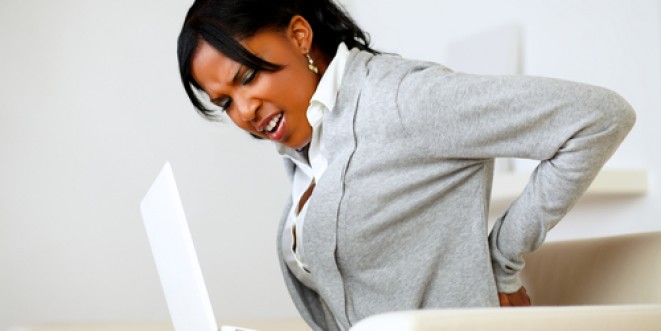I Am Always Having Back Pain. How Can I Treat It?
By Radiant HealthPublished: April 2, 2014

Expert Advice
Nearly everyone at some point has back pain that interferes with work, daily activities or recreation. Fortunately, most episodes of low back pain (LBP) go away within a few days. Some take longer or lead to more serious conditions.
As people age, bone strength, muscle elasticity and tone tend to decrease. Pain can occur when, for example, someone lifts something too heavy or overstretches, causing a sprain, strain, or spasm in the muscles or ligaments of the low back. If the spine is overstretched or compressed, cushions between the bones (vertebrae) of the spinal column, called discs, may rupture or bulge outward, putting pressure on the nerves rooted in the spinal cord, resulting in back pain.
Most low back pain follows injury to the back, but pain can also be caused by degenerative disease, such as arthritis, disc disease, osteoporosis and some viral infections. Obesity, smoking, stress, poor physical condition, poor sleeping position, and inappropriate posture may contribute to LBP. Scar tissue can form when the back heals, which is not as strong or flexible as normal tissue. Buildup of scar tissue from repeated injuries weakens the back and can lead to more serious injury.
Occasionally, LBP may indicate a serious medical problem. Pain with fever, loss of bowel or bladder control, when coughing, and progressive weakness in the legs may represent a pinched nerve or more serious problem. A person with severe back pain radiating down the leg should contact a physician immediately to help prevent permanent damage.
Men and women are affected equally. LBP occurs most often between the ages of 30 and 50 years. It’s due in part to aging, but also to a sedentary lifestyle with too little exercise (sometimes too much exercise). The risk of LBP from disc disease or spinal degeneration increases with age. LBP is unusual in pre-teen children, but an overloaded backpack can quickly strain the back and cause muscle fatigue.
Conditions that may cause LBP and require treatment by a physician or other health care provider include (not all-inclusive):
Bulging disc. (also called herniated or ruptured disc). The discs, cushions between vertebral bones, may be compressed, bulging out and placing pressure on nerves with roots in the spinal code.
Sciatica. A herniated or ruptured disc may press on the sciatic nerve, a large nerve rooted in the spinal cord, passing through the pelvis, and radiating down the leg, causing a burning or shock-like pain down the leg, along with pain in the buttocks.
Spinal degeneration. With aging, the discs suffer normal wear and tear.
Spinal stenosis. Congenital narrowing of the bony canal through which the spinal cord passes, may, later in life, squeeze around the circumference of the nerve.
Fibromyalgia. This chronic disorder is characterized by wide-spread musculoskeletal pain, along with fatigue and other symptoms. There are many “tender points,” which are particularly painful when touched. They are concentrated in the neck, upper back, shoulders and hips. Sleep disturbance, morning stiffness and anxiety may also occur with fibromyalgia.
Diagnosis starts with a thorough history and physical. A variety of diagnostic methods are available, including X-ray imaging, discography, magnetic resonance imaging (MRI), CT scanning, boan scans, ultasound imaging, thermography, and others.
Treatment
- Most LBP can be treated without surgery.
- Hot and cold compresses may relieve pain.
- Bed-rest should last no more than 1-2 days.
- Exercise is one of the most effective ways to speed recovery and limit loss of function. Your doctor can provide information about safe exercises.
- Medications are often used to treat acute or chronic back pain, including over-the-counter analgesics, such as aspirin or ibuprofen. Prescription medications for pain relief include antidepressants and anticonvulsants. Opioids (morphine-like drugs) can be used for severe pain but only short term. Chronic use of these drugs is detrimental to the back pain, and exposes the patient to addiction.
- Other, less-common treatments include acupuncture, biofeedback, physical therapy, ultrasound, traction, and transcutaneous electrical nerve stimulation (TENS). In the most serious cases, surgery of various types may be necessary.
A healthier back starts with exercise. Someone who is inactive should start with gentle, low-impact exercises. Speed-walking, swimming, or stationary cycling, can increase muscle strength and flexibility. Yoga can help strengthen and stretch muscles and improve posture.
These are additional tips for a healthier back:
- Stretch before exercise or other strenuous activity.
- Don’t slouch. When standing, keep your weight balanced on both feet.
- At home or work, working surfaces should be at a comfortable height for you.
- Sit in a chair with good lumbar support. Stretch periodically. Rest your feet on a small stool.
- Wear comfortable, low-heeled shoes.
- Sleep on your side, on a firm surface.
- Don’t try to lift objects too heavy for you. Lift with your knees. Pull in your stomach muscles. Keep the object close to your body
- Eat healthfully, to reduce and prevent excessive weight. Make sure you get the recommended amounts of calcium, phosphorus and vitamin D.
- If you smoke, quit. Smoking reduces the blood supply to the lower spine, causing deterioration.
This content is not intended to be a substitute for professional medical advice, diagnosis, or treatment. Always seek the advice of your physician or other qualified health provider with any questions you may have regarding a medical condition. Never disregard professional medical advice or delay in seeking it because of something you have read on this Website.
For more health tips and expert advice, join our free weekly newsletter and receive a Radiant Health Magazine Issue No.06 digital issue for FREE. Download Now.
Like what you're reading? Sign up for our free newsletter and never miss a post! Plus get a FREE digital version of our Issue No.10 with sign up.

- 11 Best Health and Wellness Books to Read in 2024 - July 4, 2024
- Some Americans Will Have Medical Debt Wiped From Credit - July 9, 2022
- Natural Gas Used to Heat Homes Contains Some Harmful Chemicals - July 9, 2022
- Uterine Cancer Claims Many Black Lives - July 9, 2022
- Babies and Toddlers Get COVID-19 Shots - June 27, 2022
- FDA Bans Juul’s E-Cigarettes and Cartridges - June 27, 2022
- Polio Virus Found in London Sewage - June 27, 2022
- 200 Million Americans Are Drinking Contaminated Water - June 19, 2022
- Young Kids Can Finally Get Vaccinated Against COVID-19 - June 19, 2022
- New Regulations for Baby Sleep Products - June 19, 2022











